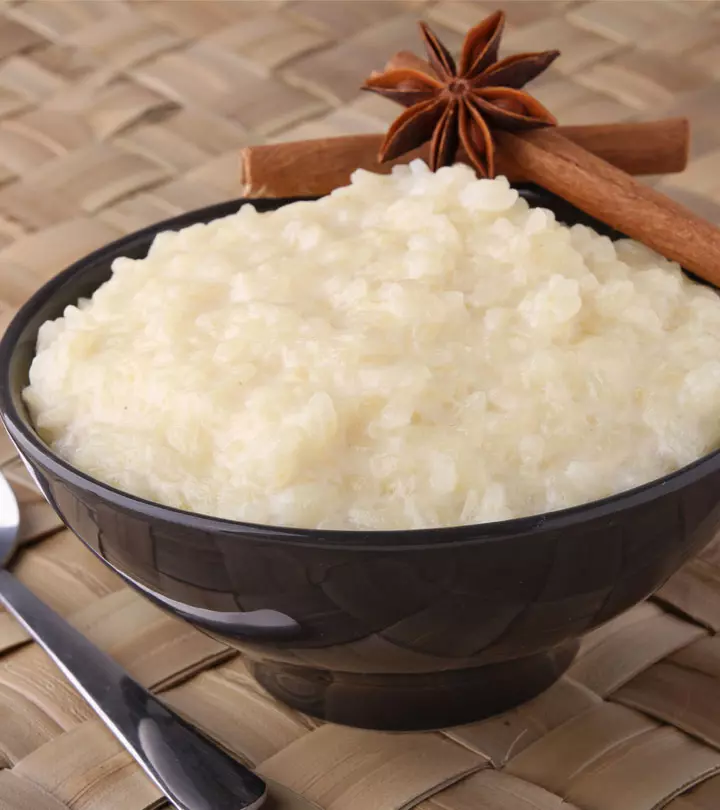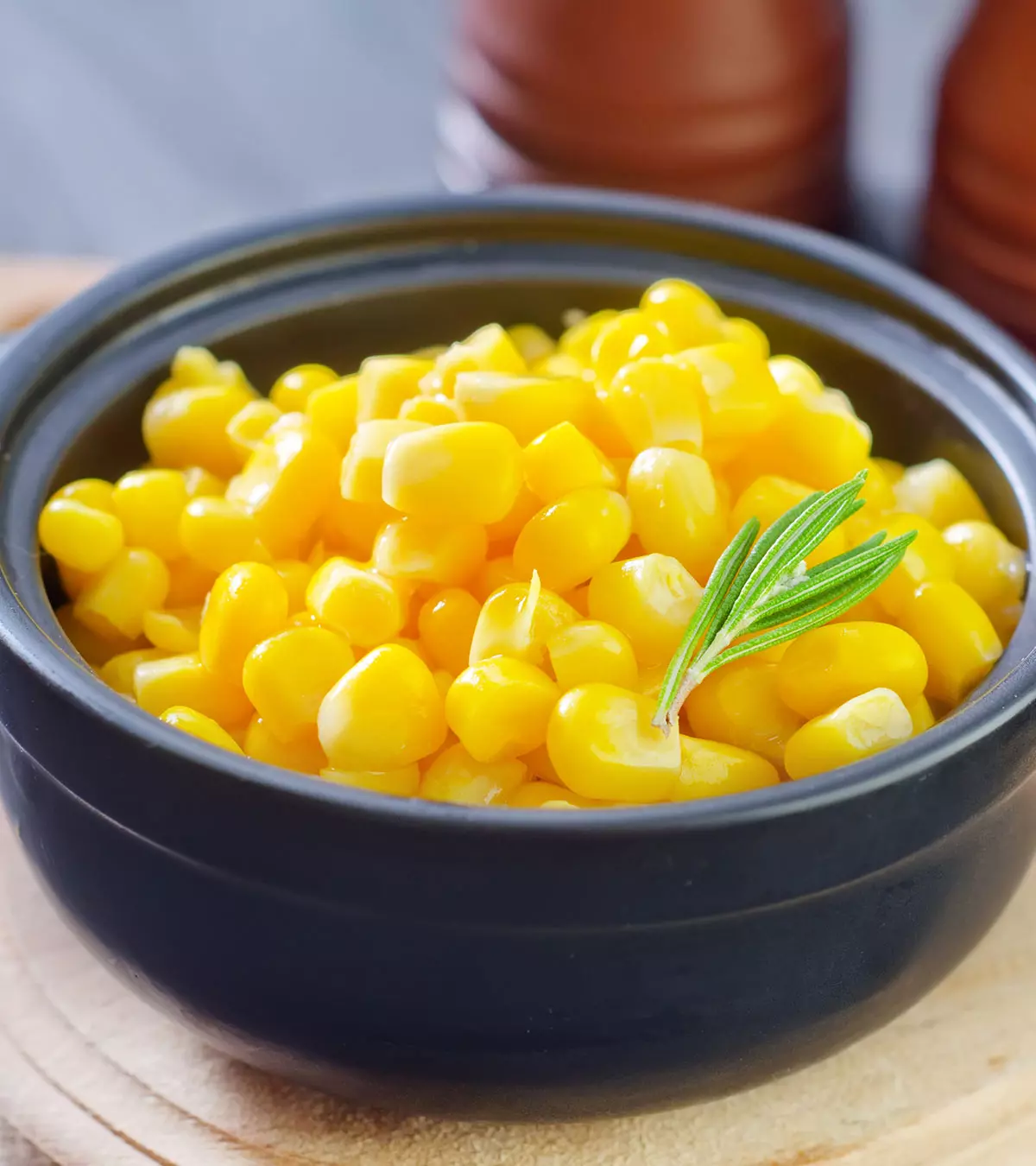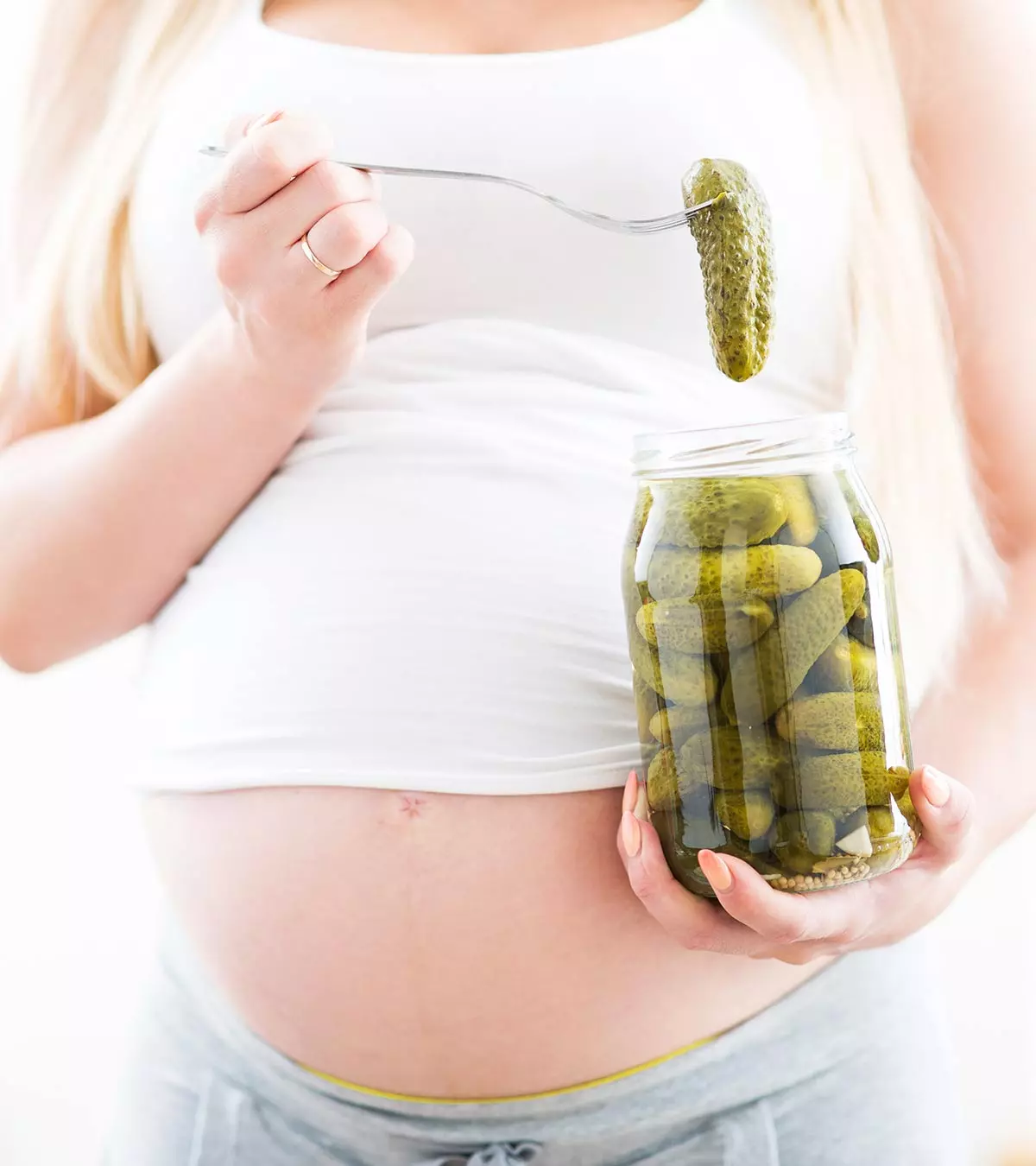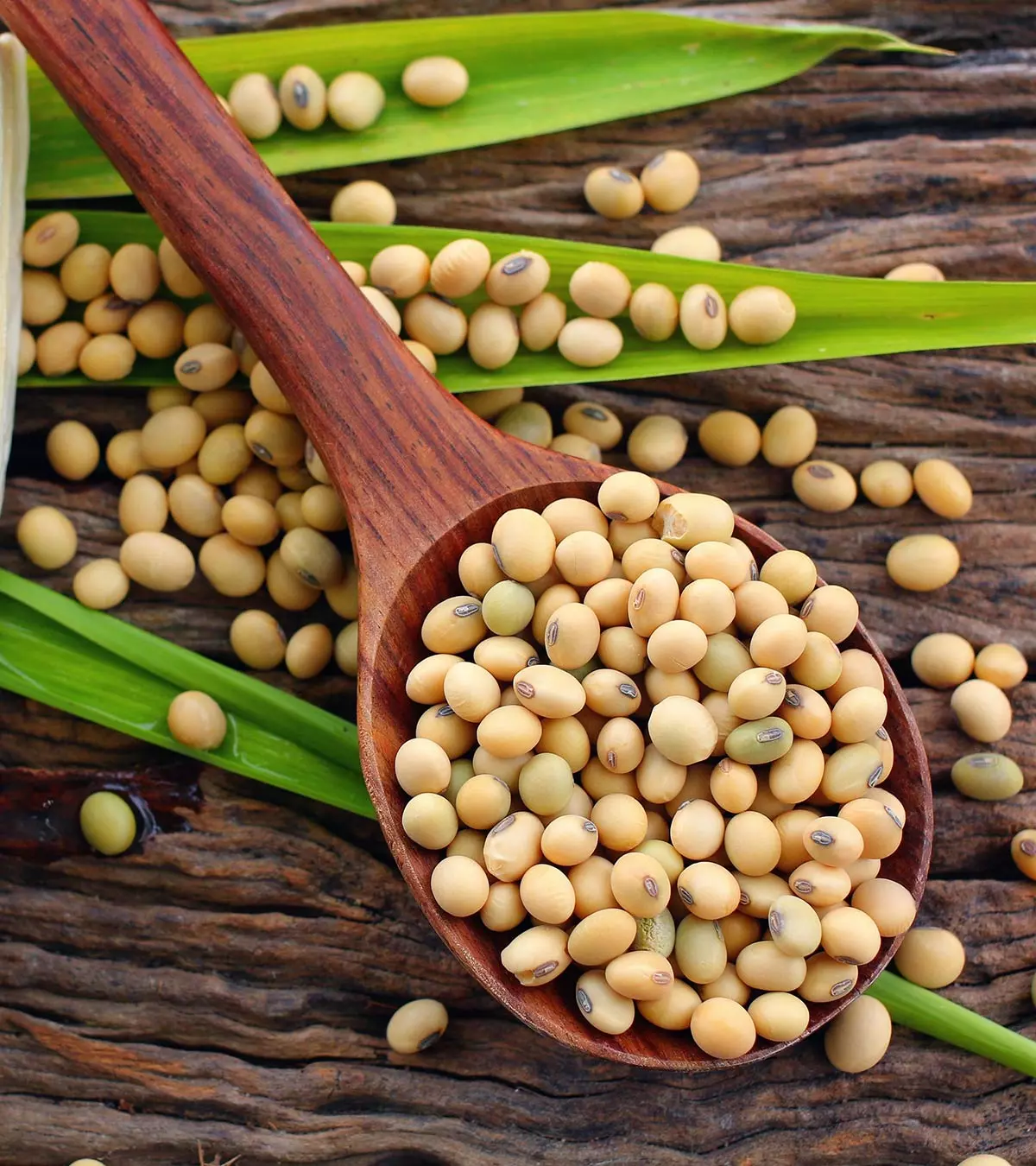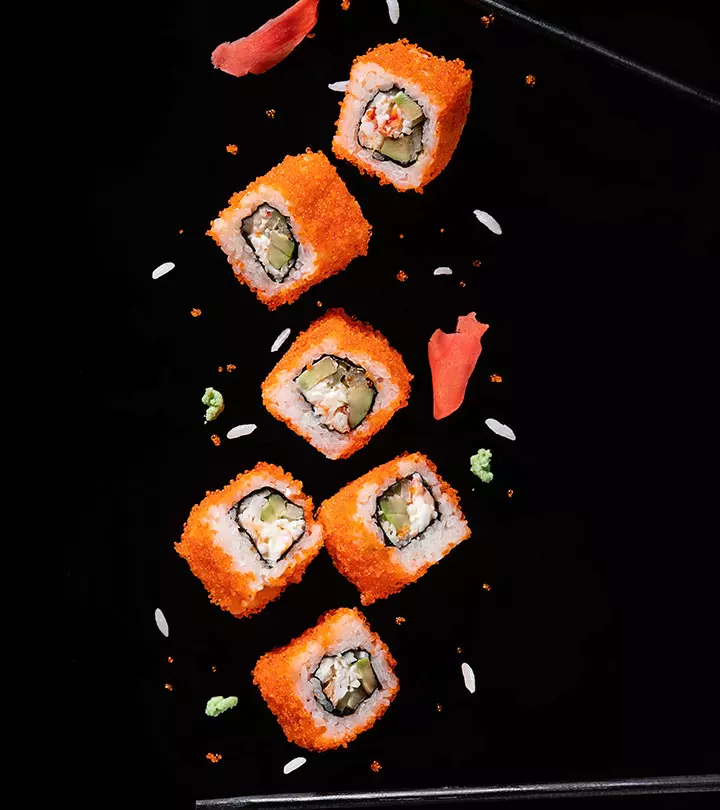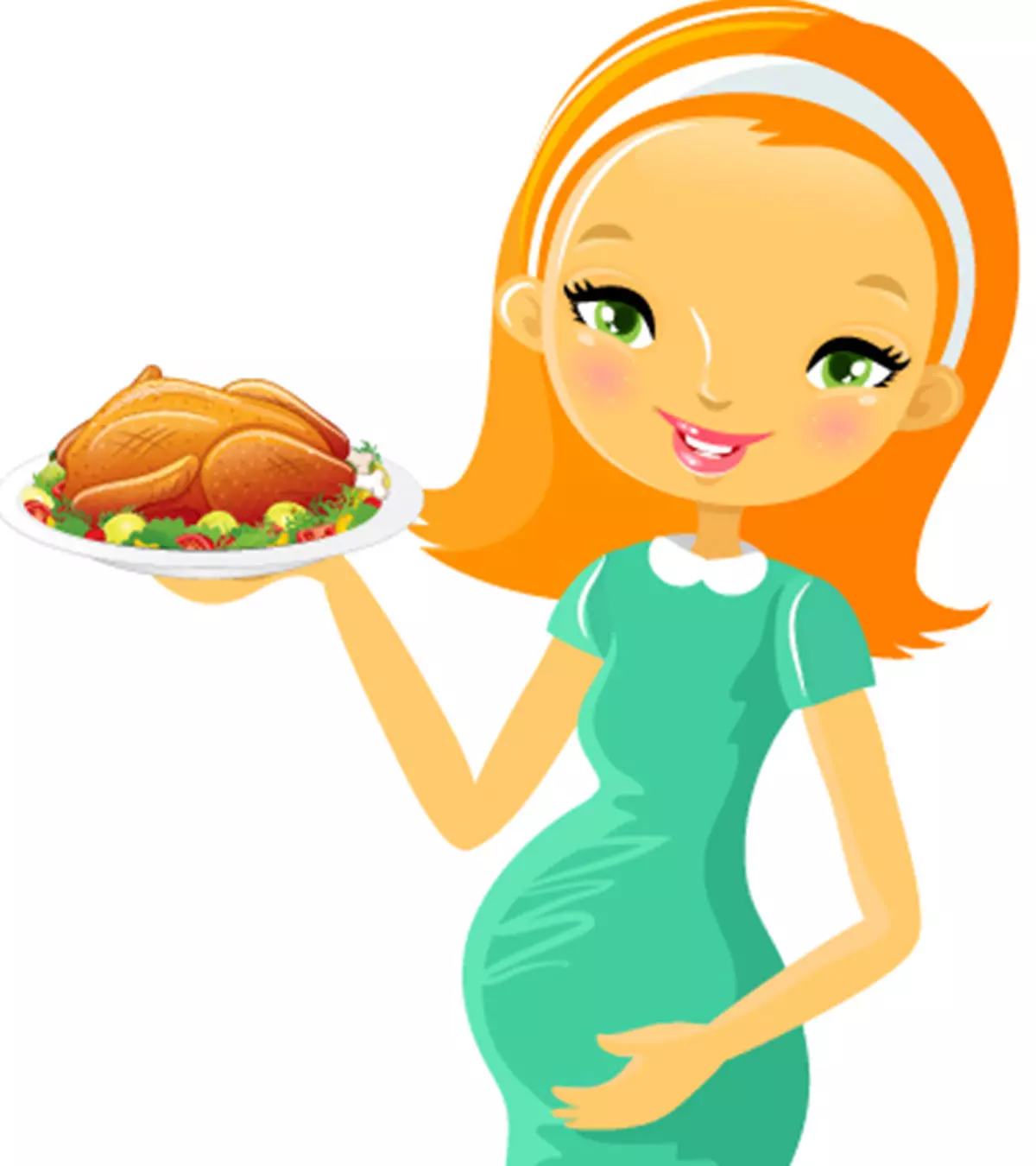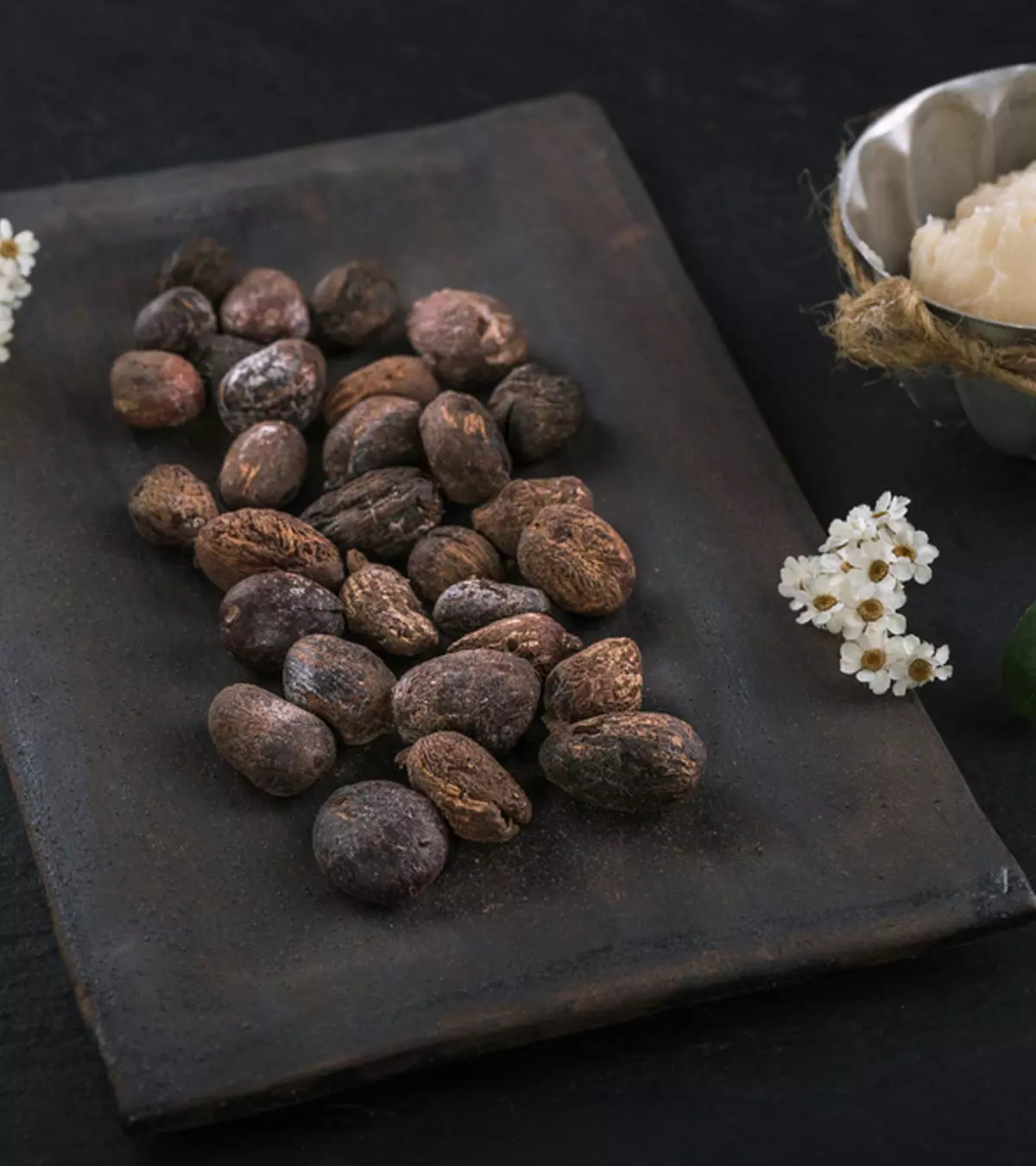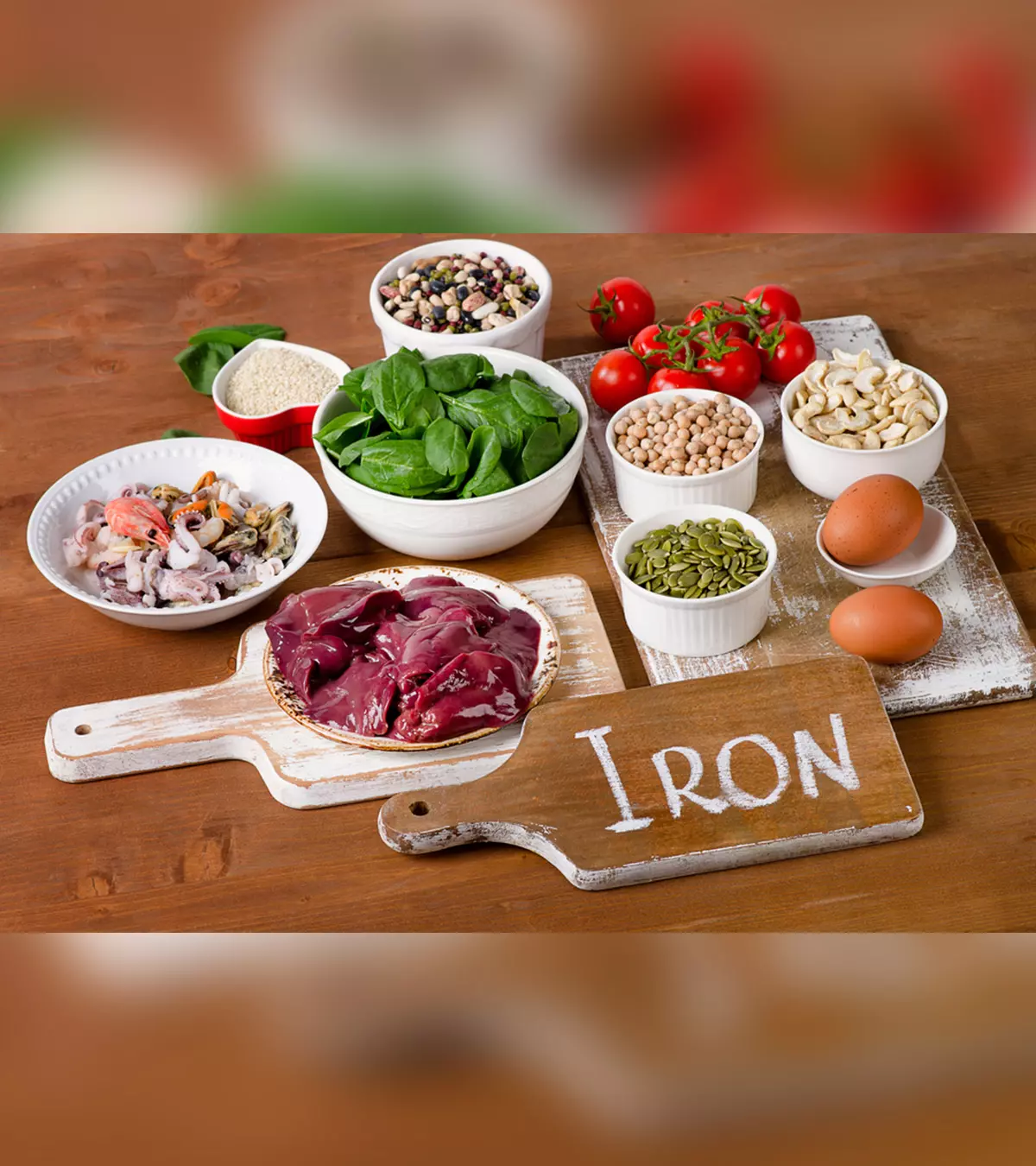
Image: ShutterStock
The benefits of iron-rich foods for toddlers are numerous as iron plays a key role in vital physiological functions, including their growth, brain development, and overall health. Most full-term babies have adequate iron levels from birth until four to six months (1). After that, their iron stores start to deplete as they grow, and weaning helps them meet their iron needs. Iron deficiency can lead to development delays and health complications. Therefore, ensuring adequate iron intake through foods is essential for toddlers and children.

Food sources contain two types of iron – heme and non-heme iron. Plant-based sources such as legumes, vegetables, and iron-fortified cereals provide non-heme iron, and animal sources such as meat, seafood, and pantry add heme iron to a toddler’s diet. The iron requirements of most babies are met by eating a well-balanced diet. However, consult a pediatrician if you are concerned about iron deficiency in your toddler.
Read on to know more about the iron requirements for toddlers, functions of iron, iron-rich foods for toddlers, and a few iron-rich recipes to try.
Key Pointers
- Children need about 11mg of iron each day to regulate energy, produce myoglobin, and neurological development.
- If your child is suffering from IDA, you may notice paleness, swelling of the tongue, and a fast heartbeat.
- To avoid iron deficiencies and anemia, include iron-rich foods such as seafood, eggs, greens, fruits, and dry fruits in your child’s diet.
- Some delicious iron-rich food recipes, including lamb soup, spinach and oats pancakes, and veggie sandwiches, are just a scroll away.
How Much Iron Do Toddlers Need?
According to the American Academy of Pediatrics (AAP), infants aged between six and 12 months need 11mg of iron each day. Toddlers aged between one and three years require seven milligrams of iron every day (2). Therefore, to meet their daily requirement for iron, you may give them a balanced diet consisting of both heme (found in meats, poultry, and seafood) and non-heme (found in plants and iron-fortified foods) iron sources. Some of the iron-rich foods that babies and toddlers should consume are legumes, poultry, meat, fortified cereals and grains, and green leafy vegetables (1).
The non-heme iron is less readily absorbed by the body when compared to heme iron. Consuming vitamin C-rich foods with non-heme iron foods enhances iron’s absorption and bioavailabilityiThe extent to which a substance can get completely absorbed into the body. . A few vitamin C-rich foods are lemon, cauliflower, guava, kiwi, orange, tomato, and potato.
Why Do Toddlers Need Iron?
Iron is an essential mineral required to produce hemoglobin, an essential protein that transports oxygen from the lungs to tissues, and carbon dioxide from the tissues to the lungs (3). Besides this, iron facilitates (4):
- Myoglobin production: Myoglobin is a protein present primarily in striated musclesiMuscles that can expand and contract independently and are under our voluntary control, such as skeletal muscles. providing them their characteristic red color. The body uses myoglobin to bind, carry, transport, and store oxygen in the muscles (5). Besides this, iron supports muscle metabolism and the development of healthy connective tissues.
- Energy production: Cells require iron-containing enzymes to convert energy from the ingested food into ATP (Adenosine Triphosphate). ATP, also known as the cell’s “energy currency,” is the body’s primary energy source (6).
- Neurological development: Iron is considered an essential nutrient for healthy neurological development in infancy and early childhood (7). Research shows that iron-deficiency in the fetal stage or during infancy can negatively affect cognitive, physical, social-emotional, and neurophysiologic development (8).
Besides these, iron helps in DNA synthesis, thermoregulationiA process by which warm-blooded animals maintain their body temperature irrespective of the outside environment. , immunity, and producing some hormones (4). Inadequate consumption of iron increases the risk of IDA (iron-deficiency anemia).
What Is Iron Deficiency And Iron-Deficiency Anemia (IDA)?
Iron deficiency is a condition in which an individual has low levels of iron in the body.
If left unattended, the deficiency can become severe, leading to iron-deficiency anemia (IDA). IDA is a state in which the hemoglobin levels drop to below-optimal levels.
In the absence of adequate hemoglobin levels, the body doesn’t produce enough red blood cells, resulting in anemia (9). The World Health Organization (WHO) reports that a considerable number of children worldwide between the ages of 6 and 59 months experience anemia, impacting around 40% of this specific age group. Excess intake of cow’s milk and insufficient iron intake are risk factors for developing iron-deficiency anemia in toddlers (10).
Note: Calcium-containing foods consumed with iron-rich foods can hinder non-heme iron absorption by approximately 50 percent (11). Serve milk to your toddler at snack times and vitamin C-rich fruit and vegetables with iron-containing foods at mealtimes for optimum iron absorption.
What Are The Signs And Symptoms Of IDA In Toddlers?
The following are the signs and symptoms of IDA that develop gradually (12) (13).
- Pale, yellow-colored skin, especially around nails and eyelids
- Brittle nails bent inwards like a spoon
- Cracked corners of the mouth
- Swelling or soreness of the tongue
- Moodiness and irritability
- Inability to concentrate for a longer duration
- Frequent fatigue and exhaustion
- Loss of appetite
- Fast heartbeat
- Enlarged spleen
- Eating disorders, such as PICA, wherein a toddler compulsively eats inedible items, such as chalk and sand.
In severe cases, IDA could lead to irreversible abnormalities of behavior and brain functions. If you observe any of the IDA-related symptoms in your toddler, consult a pediatrician.
Do Toddlers Need Iron Supplements?
Most healthy toddlers can acquire iron from a well-balanced diet containing iron-rich foods. However, if your toddler exhibits iron deficiency, your doctor may prescribe iron supplements.
Remember, just like iron deficiency, iron overload or excess can lead to health complications. Therefore, give your toddler iron supplements as directed by your doctor.
 Point to consider
Point to considerIron-Rich Foods For Toddlers
Here’s a list of iron-rich foods that you can add to your toddler’s diet in age-appropriate ways for adequate iron intake.
1. Seafood
Seafood contains a wide assortment of food items, such as fish, shellfish, oysters, clams, and shrimps. These foods are rich in high-quality, lean protein and micronutrients, such as iron, iodine, and selenium. For instance, three ounces of canned clams, oysters, and shrimp contain 23.8mg, 13.2mg, and 2.6mg of iron, respectively (14). You can prepare healthy curries, soups, casseroles, pasta, and salads with seafood such as salmon, tuna, and sardines if the toddler is not allergic to them.
2. Fortified cereals
One cup of fortified cereals contains 4.5 to 18mg of iron (15). About 28g of fortified oatmeal contains 6.92g, and 12g of fortified puffed wheat contains 3.8mg of iron (16) (17). Check the label before buying a fortified cereal to know how much you offer your toddler per serving. Oatmeal, rice flakes, muesli, and sprouted grain cereals are a few options you use to prepare delicious sweet and savory recipes.
3. Lean meat and poultry
It is one of the richest iron sources, which is relatively easy to digest for older babies and toddlers. Skinless chicken, turkey, and lamb are good options to try. Three ounces of lamb has three milligrams of iron, whereas three ounces of chicken breast has 1.1mg of iron (14). You can give your toddler lean meat curry, stew, and casserole with spaghetti or steamed rice during lunch or dinner.
 Quick fact
Quick fact4. Eggs
Whole eggs are a good source of high-quality protein and micronutrients, such as iron, folate, vitamin A, and vitamin D. One whole cooked egg contains 1.68mg of iron (18). Toddlers can reap the egg’s nutritional benefits by consuming whole eggs by trying recipes, such as an omelet or scrambled egg yolks with veggies, devilled eggs with pancakes, or an egg sandwich with lemonade.
5. Green leafy vegetables
Spinach, kale, collards, beet greens, and broccoli are good sources of iron and other vital nutrients, such as vitamin A, folate, and bioactive compounds (19). Toddlers between two and three years are advised to consume at least one cup of raw or cooked veggies per day (20). Add lemon juice to green leafy vegetables or serve them with vitamin C rich foods to enhance their iron’s bioavailability.
6. Dried fruits
Raisins, dates, figs, and prunes are iron and fiber-rich dried fruits containing several micronutrients. Add chopped dried fruits to cereals, porridge, shakes, smoothies, or prepare a trail mix. Your toddler can also eat a handful of these delicious, nutrient-rich foods as snacks instead of processed foods, such as biscuits and chips.
7. Fruits
Fresh seasonal fruits, such as watermelon, apple, apricot, pomegranate, strawberries, mulberries, and black currant, are some iron-rich foods that your toddler can consume daily. You can add fruits to different recipes or feed them to your toddler as it is. Besides iron, these fruits can provide dietary fiber, vitamins, minerals, and health-promoting phytochemicals.
8. Seeds
Pumpkin seeds are good sources of iron for a toddler. You can powder these seeds and add them to different foods, such as soups, cereals, smoothies, and shakes. One ounce (28.3g) of pumpkin seeds offer 2.3mg of iron, which can significantly contribute to your toddler’s daily iron needs Sunflower seeds are particularly abundant in iron, vitamin E, and selenium, which protect your body’s cells from free radical damage (21) (22) (23).
9. Whole-grains
Whole-grain, such as whole wheat, brown rice, amaranth, quinoa, and spelt, are good sources of iron, offering dietary fiber, B-vitamins, and bioactive compounds (24). You can prepare several tasty and healthy recipes across meals using whole grains and their products, such as whole grain bread, cereals, and pasta. Add lots of seasonal vegetables, fruits, nuts, and seeds to enhance the recipes’ taste, texture, and nutritional value.
10. Legumes
The Dietary Guidelines of American 2015-2025 recommends eating half a cup of legumes (beans, peas, or lentils) per 1000 calories a week (25). Curries, soups, stews, sandwiches, salads, and casseroles are delicious dishes you can prepare using cooked and sprouted legumes. Some of the iron-rich legumes you can add to your toddler’s daily diet are soybean, black beans, kidney beans, chickpeas, lentils, and split peas.
11. Nuts
Almonds, cashews, pine nuts, walnuts, macadamia, and hazelnut can offer good amounts of iron per serving. You can add raw, soaked, roasted, or powdered nuts to foods, such as milk, yogurt, smoothies, and cereals. Homemade nut butter and nut spreads are other ways to let your toddler enjoy the benefits of nuts.
Tasty And Healthy Iron-Rich Recipes For Toddlers
Below are some mouth-watering and healthy iron-rich recipes that your toddler can relish comfortably.
1. Lentil soup
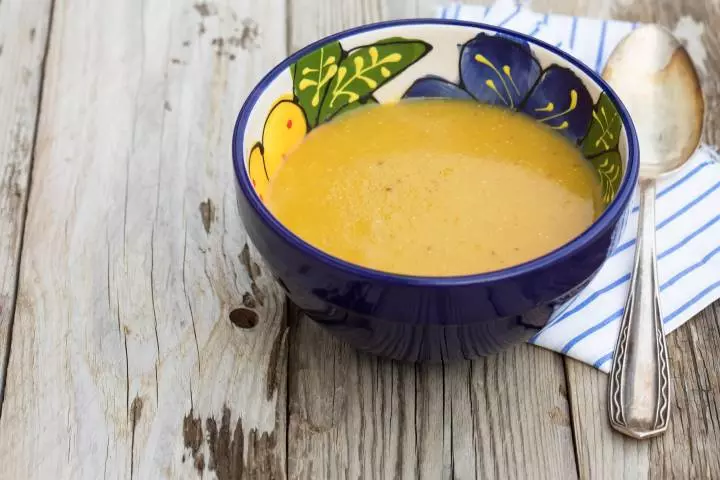
You will need:
- 1tbsp olive oil
- 1 garlic clove (crushed)
- 1 medium onion (diced)
- 2 medium carrots (grated)
- 1tsp ground cumin
- 150g dried red lentils (soaked overnight)
- 4 cups vegetable stock
- ½ cup milk (any preferred choice of milk)
How to prepare:
1. In a medium-sized pot, heat the olive oil over medium heat.
2. Add the crushed garlic and diced onion. Sauté until the onion becomes translucent and aromatic.
3. Stir in the grated carrots and cook for an additional 2-3 minutes until they begin to soften.
4. Add the ground cumin to the pot, stirring well to coat the vegetables with the aromatic spice.
5. Drain and rinse the soaked lentils thoroughly. Add them to the pot, stirring to combine with the vegetables.
6. Pour in the vegetable stock, ensuring it covers the ingredients. Bring the mixture to a gentle boil.
7. Once boiling, reduce the heat to low and let the soup simmer. Cover the pot with a lid and let it cook for about 20-30 minutes or until the lentils are tender.
8. Stir in the milk (or dairy-free alternative) to add creaminess to the soup. Simmer for an additional 5 minutes.
9. Taste the soup and adjust the seasoning if needed. You can add a pinch of salt or pepper according to your toddler’s taste preferences.
10. Allow the soup to cool slightly before serving. Ensure it is at a safe temperature for your toddler to enjoy. You can also blend the soup until you achieve a smooth consistency.
2. Lamb soup

You will need:
- 200g lean lamb leg steak (diced)
- 100g squash or pumpkin (peeled and chopped)
- 100g parsnips
- 1 celery stalk
- 1 small onion (peeled and chopped)
- 8 to 10 cups water
How to prepare:
- Put all the ingredients into a big pot over medium heat. Add around eight cups of water and bring the mixture to a boil.
- Reduce the flame to low and let the mixture simmer for two hours, adding extra water if necessary.
- After two hours, pour some soup with lamb pieces into a feeding bowl. Feed this sumptuous soup to your toddler at lunch or dinner.
3. Beef stew with veggies
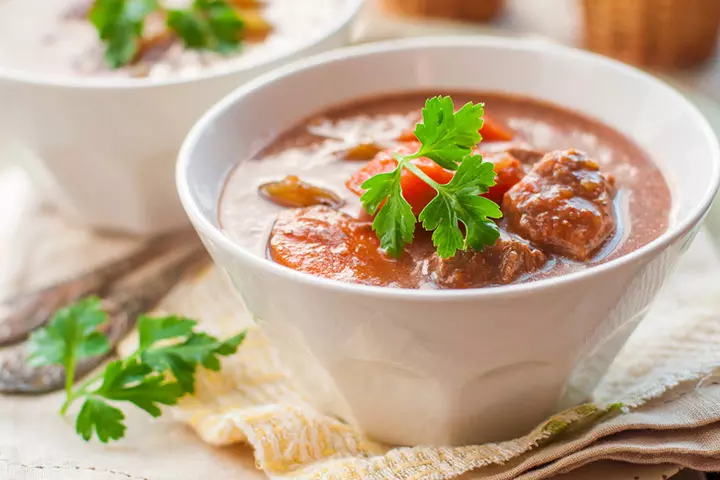
You will need:
- 100g chuck roast (trimmed and cut into cubes)
- 1 cup diced frozen onion
- 300ml reduced-sodium beef broth
- 1 can (14.5oz.) tomatoes
- 4 potatoes (peeled and quartered)
- 3 carrots (peeled and chopped)
- 1 rib celery (chopped)
- ¼ cup all-purpose flour
- ¼ cup cold water
- ½ cup frozen corn
- ½ cup frozen peas
- 2tbsp dried parsley
- 2 bay leaves
- 1tbsp canola oil
- 1tbsp unsalted butter
- Salt and black pepper, to taste
How to prepare:
- Apply salt and black pepper to the beef. Set aside.
- Heat canola oil and butter into a pressure cooking pot over medium heat.
- As the butter begins melting, put beef chunks and fry them until the pieces turn brown. Once done, transfer all the chunks to a plate.
- Then, add chopped onion to the cooking pot and saute for about two to three minutes, until they turn translucent.
- Add beef broth, crushed tomatoes, parsley, bay leaves, and beef chunks. Lock the lid and cook the mixture at high pressure for ten minutes.
- After ten minutes, let the pressure release, and once done, remove the lid.
- Add the potatoes, carrots, and celery. Lock the lid again and cook the mixture again on high pressure for two to three additional minutes.
- After three minutes, remove the pressure cooker from the heat. Let the pressure release. Remove the lid and discard the bay leaves.
- Whisk all-purpose flour and cold water into a lump-free, smooth paste. Add the flour paste to the beef mixture with frequent stirring until it thickens.
- Add corn and peas and bring the mixture to a boil for ten minutes over low heat.
- After ten minutes, turn off the heat and transfer the stew into a serving bowl.
4. Spinach and oats pancakes
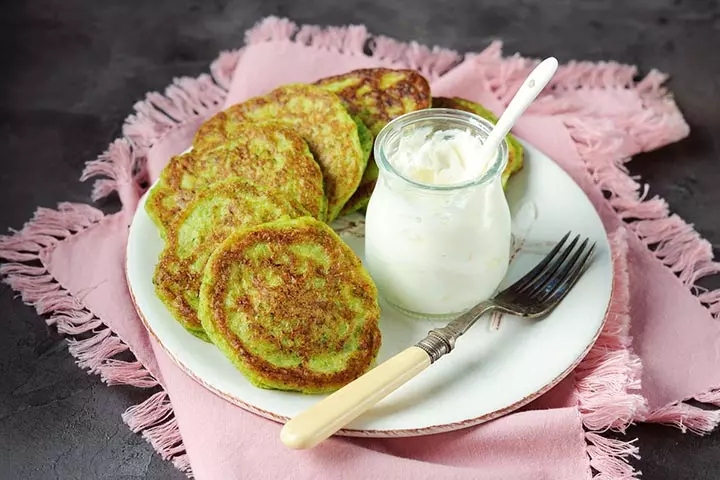
You will need:
- 1 cup oats flour
- 1 cup spinach (finely chopped)
- 2tbsp pumpkin seeds
- 2tbsp jaggery powder
- ½tsp baking powder
- ¼tsp baking soda
- ½tsp sea salt
- ½tsp cinnamon powder
- ¾ cup whole milk
- ¼ cup plain Greek yogurt
- 1 large egg
- 2tbsp ghee or clarified butter
How to prepare:
- Blend pumpkin seeds, baking powder, baking soda, salt, jaggery powder, cinnamon powder, and oats flour into a fine powder using a blender. Ensure no lumps are present.
- Add milk, Greek yogurt, and spinach and blend again to make a lump-free, smooth batter.
- Lastly, add egg and blend again to mix everything well. Set aside.
- Then, heat ghee in a skillet over medium heat.
- Once the ghee warms, spread a cup of pancake batter onto the skillet. Cook each side of the pancake for five minutes until it turns brown and crispy.
- Transfer the pancake to a plate and serve warm with a cup of milk or applesauce.
5. Veggie sandwich

You will need:
- 2 slices whole-grain bread (toasted)
- ¼ cup fresh baby spinach (chopped)
- ¼ cup bean sprouts (cooked)
- 2tbsp peanut butter
- Hummus
- 1tsp toasted sesame seeds
How to prepare:
- Spread peanut butter or hummus on both slices of bread.
- Layer one slice with spinach, sprouts, and toasted sesame seeds. Put another slice on the top. The sandwich is ready.
- Cut the sandwich into four pieces, place it on the serving plate, and feed your toddler as healthy finger food.
6. Fruit and nuts smoothie

You will need:
- 1 cup fortified whole milk
- ½ cup strawberry (chopped)
- ½ cup banana (chopped)
- ½ cup blueberries (chopped)
- 2tbsp rolled oats
- 2tbsp dried fruit powder
- 1tsp jaggery powder
How to prepare:
- Blend all the ingredients into a lump-free smooth liquid using a blender.
- Pour the smoothie into a cup and feed.
7. Tuna pasta
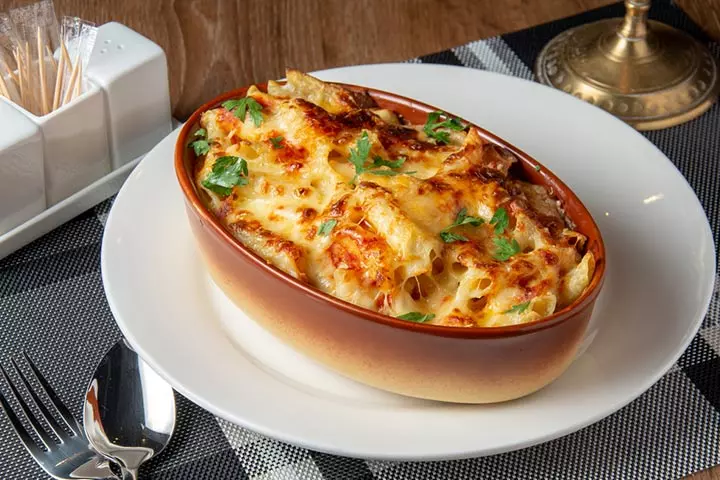
You will need:
- 50g anellini pasta (cooked)
- 30g frozen pea (boiled)
- 20g unsalted butter
- 20g wheat flour
- 200ml whole milk
- 1 cup tuna (shredded)
- ½ cup spring onions (chopped)
- ½ cup tomato (chopped)
- ¼ cup sweetcorn
- 2tbsp goat cheese (grated)
- 1tsp Dijon mustard
- 1tsp Italian seasoning
How to prepare:
- Melt the butter in a saucepan over low heat. Add flour and cook for two to three minutes while stirring continuously.
- Add milk and bring the mixture to a boil with occasional stirring until the mixture thickens.
- As the mixture begins boiling, turn off the heat and add Dijon mustard and Italian seasoning. The sauce is ready.
- Pour half of the sauce into a shallow baking dish and stir in tuna shreds, spring onions, tomato, sweetcorn, and pasta. Pour the remaining sauce over and top with grated cheddar.
- Heat a grill to medium heat and place the dish under the grill for five to eight minutes, until the crust turns golden brown and cheese begins bubbling.
- Switch off the grill and serve hot.
All these recipes are toddler-friendly. But since toddlers can be picky about their food, offer a variety of iron-rich foods to keep the meals interesting and appealing to them.
Frequently Asked Questions
1. How can I increase my toddler’s iron level?
Iron-rich foods, such as iron-fortified cereals, red meat, and iron-enriched vegetables, can help increase your toddler’s iron levels. Besides, you should include vitamin C in your toddler’s diet because it aids in iron absorption. However, be cautious when you pair iron-rich foods with calcium-rich foods like milk since calcium can inhibit iron absorption from plant sources (10).. In severe cases of iron deficiency in children, especially if they are vegetarian or have dietary restrictions, your pediatrician may also prescribe iron supplements for several weeks (26).
2. Are bananas high in iron?
No, bananas have a low iron content of around 0.4mg/100g fresh weight. However, research has shown that genetically modified bananas can have high iron content (27).
3. How does iron deficiency affect children’s behavior?
Iron deficiency can adversely affect children because iron is required for myelin formation (brain tissue), neuro-metabolismiThe aspects of metabolism controlled by the brain. , and neurotransmitteriChemical messengers in the brain that send signals throughout the body to carry out different functions. synthesis. They tend to be irritable, disruptive, non-attentive (or attentive for a short period), and uninterested in their surroundings. They have also been shown to perform poorly in academics (28).
4. What is the most iron-rich fruit?
Prunes or prune juice, figs, dates, and raisins are some of the most iron-rich fruits you can add to your toddler’s diet in age-appropriate forms (29). For instance, you can mash cooked prunes, figs, dates, or raisins and spread them on bite-sized bread pieces to create a healthy and delectable finger food for your toddler.
Iron is an important mineral required for supporting crucial body functions in children and adults. Hence, it is essential to support your toddler’s nutritional needs by including appropriate iron-rich foods for toddlers in their diet. Some easily available iron-rich foods you may try are fruits, leafy greens, fish, cereals, nuts, and legumes. Incorporate these foods in your toddler’s favorite meals, such as pancakes, salads, and stews, to ensure their body gets sufficient amounts of this mineral and aid in their healthy development.
Infographic: Precautions To Take While Using Iron Supplements For Toddlers
Iron supplementation is an effective tool to combat iron insufficiency/deficiency. Yet, one must avoid iron overuse to avert potential health risks. Our infographic shares the precautions parents should take while using iron supplements for toddlers. It also gives an insight into the possible side effects of iron supplement overuse.
Some thing wrong with infographic shortcode. please verify shortcode syntax
Illustration: Healthy Iron-Rich Foods For Toddlers & 6 Recipes To Try

Image: Dall·E/MomJunction Design Team
Learn about the best iron-rich foods for babies, toddlers, and children in this helpful video. Also, discover how to incorporate these foods into your child’s diet for optimal health.
References
- Infant Nutrition and Feeding; USDA
- Iron; Seattle Children’s
- Hemoglobin and Functions of Iron; University of California San Francisco
- Iron; NIH; US Department of Health And Human Services
- Trey Vanek and ArpanKohli; Biochemistry, Myoglobin; NCBI
- Iron: An Essential Nutrient; Colorado State University Extension
- Iron; CDC
- BetsyLozoff and Michael K.Georgieff; Iron Deficiency and Brain Development; Science Direct
- How a lack of iron leads to anemia; eLife Sciences Publications
- Iron; Victoria State Government
- Pump Up the Diet with Iron; AAP
- Iron-Deficiency Anemia; American Society Of Hematology
- Iron-Deficiency Anemia; Kids Health From Nemours
- Iron-Rich Foods; Cedars Sinai
- Iron Deficiency Anemia; C.S. Mott Children’s Hospital
- Cereals, oats, instant, fortified, plain, dry; FDC ID: 171661; FoodData Central; USDA
- Cereals ready-to-eat, wheat, puffed, fortified; FDC ID: 173913; FoodData Central; USDA
- Egg, whole, cooked, NS as to cooking method; FDC ID: 1100184; FoodData Central; USDA
- How to Get Your Kids to Eat Dark Leafy Greens; Eat Right; Academy of Nutrition And Dietetics
- All about the Vegetable Group; Choose Myplate; USDA
- Pumpkin seeds, unsalted; FDC ID: 1100603; FoodData Central; USDA
- Vitamin E; National Institutes of Health
- Seeds, sunflower seed kernels, dried; U.S. Department of Agriculture
- Whole Grains; Oregon State University
- Table A3-1 – Healthy U.S.-Style Eating Pattern: Recommended Amounts of Food From Each Food Group at 12 Calorie Levels; Dietary Guidelines For Americans 2015-2025
- Iron-Deficiency Anemia in Children; Cedars-Sinai
- Olga P. García et al.;Iron absorption in raw and cooked bananas: a field study using stable isotopes in women; NCBI
- Garima Mahajan et al.;Iron Profile in Children with Behavioural Disorders: A Prospective Study in a Tertiary Care Hospital in North India; NCBI
- How to Add Foods That Are High in Iron to Your Diet; Cleveland Clinic
- Iron for toddlers and children; Queensland Government
Community Experiences
Join the conversation and become a part of our nurturing community! Share your stories, experiences, and insights to connect with fellow parents.
Read full bio of Jennifer Swallow
Read full bio of Swati Patwal
Read full bio of Rohit Garoo
Read full bio of Ghazia Shah








